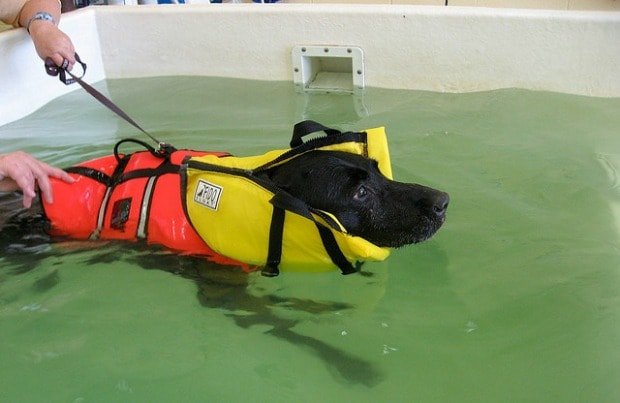Most dogs, especially webbed-foot breeds like Retrievers and Labradors, love to jump in the water and cool off on hot days. But movement in water can also heal ailments, relieve pain, and even provide emotional benefits to canines. Read on to find out what’s so great about pooches in therapeutic pools.
Dog Hydrotherapy 101
Hydrotherapy began as a treatment for humans in ancient times and expanded to include animals when racehorses began benefiting from seawater. Greyhounds dove in on the action to improve their strength and speed, as well as heal injuries from the rigors of racing.
Hydrotherapy eventually became recognized and used as a therapeutic option for all dog breeds to improve medical conditions and even aid their emotional states.
During hydrotherapy sessions pups are either submerged with a hoist, or walked down a ramp, into a small heated pool with water jets for resistance and kept in place during therapy with leashes and harnesses. The pool water is treated with chlorine or alternative chemicals to keep it clean and safe for multiple pooch use.
Benefits of Dog Hydrotherapy
Cindy Horsfall, known as the “canine water-therapy pioneer” and owner of La Paw Spa, states that hydrotherapy improves the physical and even emotional conditions of doggies. Here are some of the particular positive outcomes of her experiences with canines:
Physical: Movement in water provides increased resistance to amp up the effects of exercise, reaping the benefits of a five-mile run from a five-minute swim. The buoyancy of the water allows overweight or disabled dogs to perform non-weight bearing exercise with reduced stress on their joints and promotes quicker healing from surgery due to increased circulation. All systems of the body—skin, muscle, nervous, circulatory, endocrine, lymphatic, respiratory, digestive, urinary, reproductive and skeletal—are simultaneously relaxed and stimulated in water-immersed therapy. Coat and skin conditions are eliminated, pain and spasms are reduced, stress is decreased and metabolic functions and hormones are stimulated. Hydrotherapy can also help drain lymphatic fluid, decrease inflammation, improve digestion, and increase a dog’s range of motion.
Emotional: Canines who are getting older and losing mobility experience sadness and fear, especially when their conditions cause pain and uncomfortable procedures like getting shots or surgery. The support of water and relief from physical pain promote a sense of safety and wellbeing that relieves dogs’ minds. Considering that the physical body of pooches is made up of more than 60% water, getting into a pool provides a feeling of completion and harmony.
Health Problems Improved With Hydrotherapy
In addition to providing general fitness benefits, water exercise overcomes the physical limitations that come with age. Arthritis and problems with immobility are improved with hydrotherapy. Water therapy also helps heal dogs after surgery due to the increased circulation from being immersed in water. Regular therapy sessions can also help obese pups slim down without the strain of running or exercising outdoors in warm weather. Dysplasia, an abnormal formation of the hip socket, can also be helped with hydrotherapy exercise.
Into the Water and Liking It
Fortunately, most pups’ natural inclination towards loving the water makes hydrotherapy an especially dog-friendly form of healthcare. Pet parents of dogs who are not so fond of immersion can help their furry friends by carefully choosing an empathetic Certified Aquatic Therapist. A positive connection established between your pooch and his therapist can quell his fears of being in the water. Approaching sessions as a training experience, with lots of praise and treats followed by quality time with your pup after his appointments, can help him view the experience in a positive light. Until he starts looking forward to his plunges into the pool, stress-reducing products for pets can help calm him down.
Typical Hydrotherapy Schedule and Fees
Certified Aquatic Therapists can be found all over the United States and around the world, and their fees vary according to factors such as level of experience, location of practice and degree of services needed. For instance, aquatic therapy appointments in California cost $50 for 60 minutes, compared to Cindy Horsfall’s fee of $125 for an hour. Horsfall says that frequency of sessions is impacted by “about 20 different variables” and can range from eight appointments for simple issues like respiratory improvement, to years of therapy for a paralytic pup. The best thing to do, she says, is to consult with your therapist and veterinarian about the goals of treatment and the number of sessions it will take to achieve them.
Valerie Trumps
Share:










